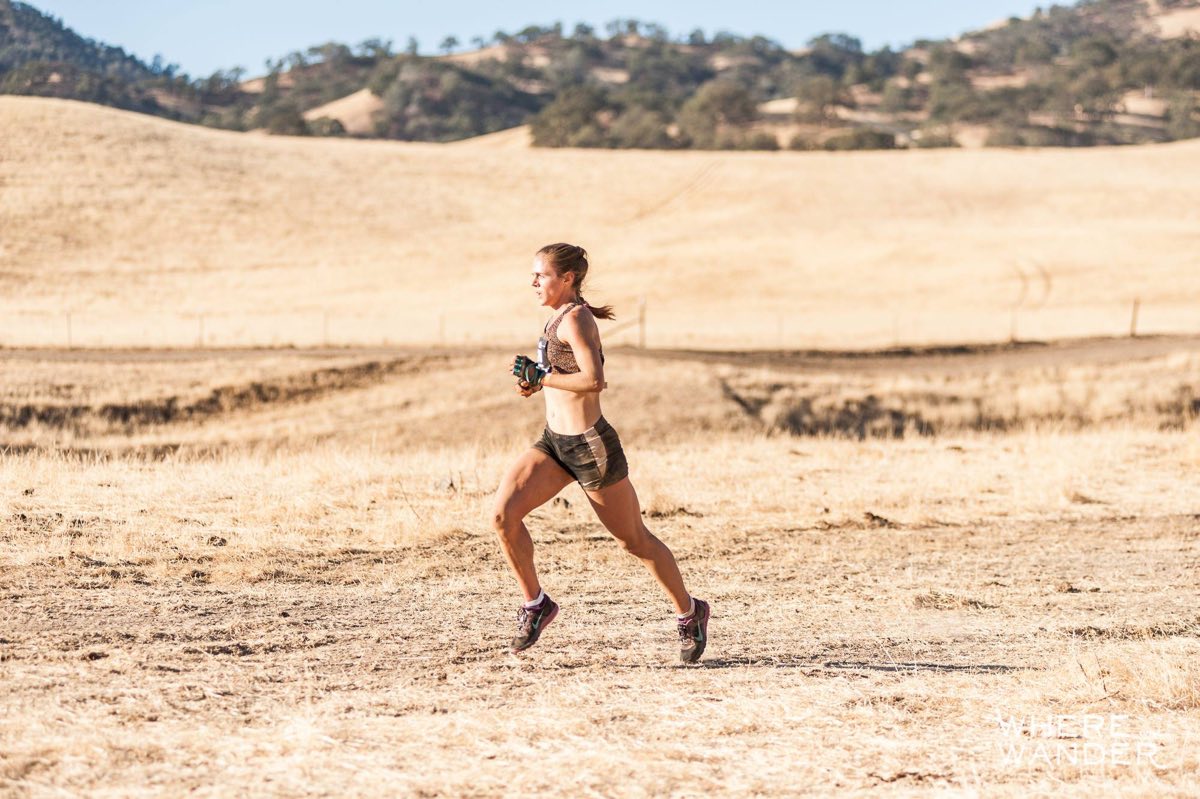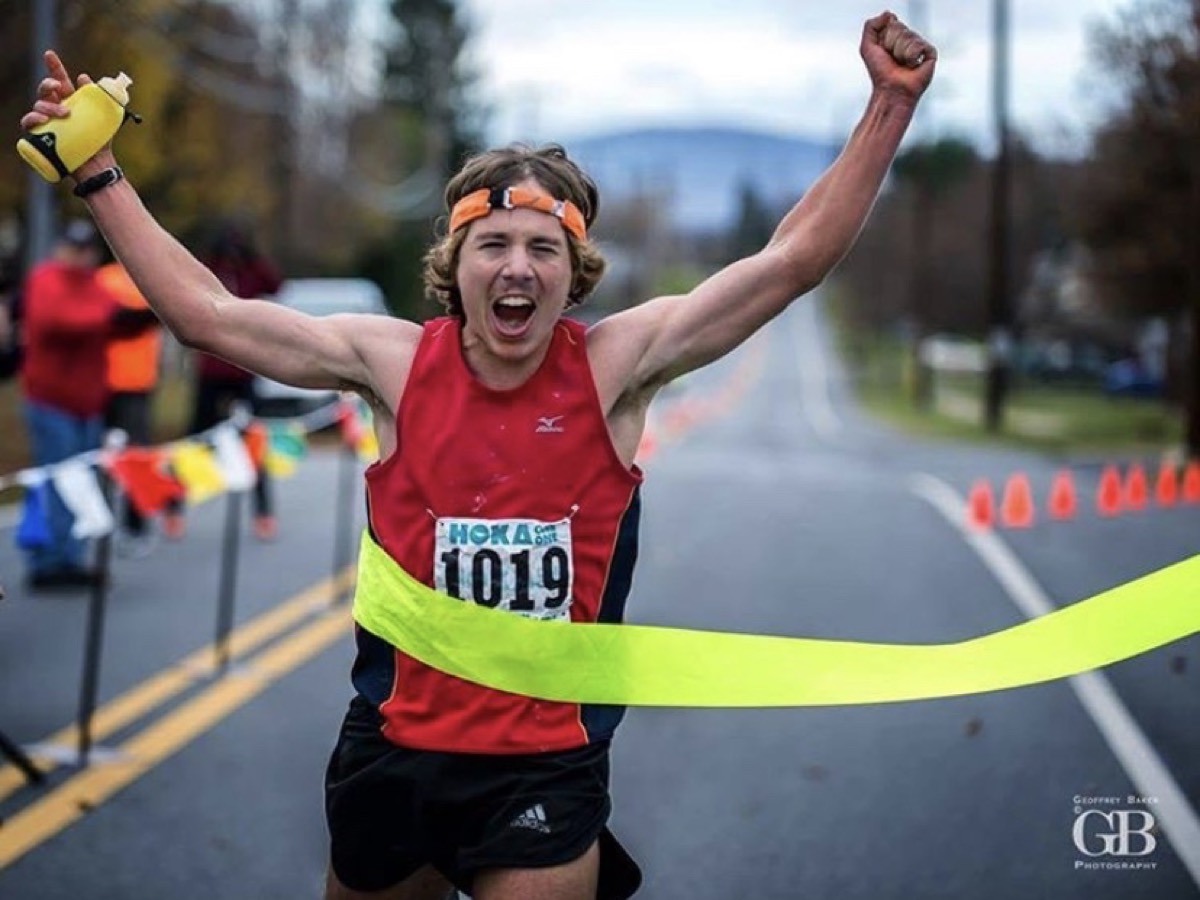[Editor’s Note: In his ‘Finding Words’ column this month, Zach Miller coauthors with trail runner, obstacle racer, and coach Kimber Mattox.]
Zach Miller: At 6 a.m. on December 18, my alarm sounds. I’m buried in my sleeping bag in the back of my truck just outside of Boulder, Colorado. From between the wheel well and a pile of gear that includes bikes, splitboards, snowboard boots, and more, I rise reluctantly. I pull on one layer, then another, slip on my shoes, pop the window of my truck’s topper, drop the tailgate, and crawl out into the dark morning.
Feet on the ground, I retrieve my gear for a sunrise run. Many days of the year there would be little to grab. Shorts, a shirt, socks, and shoes are about all that’s needed during the warm days of summer. Now it’s winter and though my run will only be about 30 minutes long, I need a more extensive quiver of gear. I also need a headlamp, gloves, a long-sleeve quarter-zip shirt, a warm jacket, and two BUFFS. Together this comprises my winter running toolkit. These tools can’t crank out my miles for me, but they equip me with the warmth and protection that I need to do my best work.
Kimber Mattox: What’s in your toolbox? Looking into mine, I see the tools I use all the time as well as a couple I never thought I would need until that one time when there was no other tool for the job. And when I look into my friends’ toolboxes, I see that we have some of the same tools, but they also have a couple that I wish for but might never get myself.
Zach: I grew up working alongside my dad, a mason, and my grandpa, a carpenter. I think my grandpa’s toolbox was a big, wooden, and with a dowel rod for a handle. When I was young, they took me under their wings and taught me to work with my hands. They passed on their knowledge, lent me their tools, and showed me that a toolbox is meant to be shared.
Kimber: Literal toolboxes, our collection of gadgets we use to fix roof leaks and tune car engines, and figurative runner toolboxes, the skills, abilities, and gear we call upon in our sport, have a lot in common. In this article, we look into our own toolboxes, to see what tools we each have and what we still need, and we also encourage you to think about how to best build and use your own.
One thing I have learned about tools is that we have to first recognize them before we can learn how and when to use them. When I first started trail running, I was mostly a track athlete and I trained like one. I hit speedy splits on the track, did squats and deadlifts in the weight room, and cruised on some moderately hilly trails for long runs. Maybe like a power saw, I was sharp and fast, but there was nothing particularly skillful about my trail running.
After making my little muddy footprint in the trail world, I became injured for about three years. When I could finally run again, I thought I had to do return to speedy track workouts, heavy weights, and fast 5ks. The problem was, I couldn’t do any of those things anymore–my body just wouldn’t let me. One day on a frustrated run, I remember telling myself, “If you want to be competitive again, you have to become a different kind of athlete. You have to find a different way.” I realized that I needed new tools to get this job done.
That’s when I found hiking, or what I think of as my hammer. In my first trail race, I didn’t realize that it was okay to hike, so I ran the whole thing. Thank goodness for other trail runners who’ve helped me recognize hiking as a tool. Now it has become one of my trusty skills, allowing me to pound my way up steep climbs and win races. If I had only one tool in my trail running toolbox, my hammer–a strong powerhike–could get the job done most of the time.
I’ve also learned that it’s easy to lean too heavily on our trusted tool and forget about another that could be much more effective. Sometimes you just need a nail gun to power out a lot of work fast and run up that hill, even if it might run out of battery power eventually. Some runners are very good at running on the steep, nasty uphills, and this is a tool I’m trying to recharge. I’m trying to run a little more and hike a little less, to be comfortable with uncomfortable uphill running, and to learn the right times to run and the right times to hike. I’m putting some power back into my power tools.
Zach: Taking inventory of my toolbox, I notice that my shovel is bigger than most of my other tools. My shovel is my body’s ability to endure and dig really deep. In training, it translates to putting in lots of work. In racing, it means persisting when it starts to hurt. My shovel isn’t fancy fiberglass or shiny stainless steel. It’s a standard dirt shovel with a sturdy wooden handle and a strong blade. It’ll rot and rust if left out in the elements, but will be faithful and strong if cared for. And, most importantly, it can dig, and dig, and dig. When utilized in the right way, each shovelful contributes to new a new layer of fitness, a stronger body, and in theory, a better race.
But that’s only if it’s used correctly. Sometimes my shovel gets abused, and I dig a hole so deep that it collapses around me. Just as Kimber says she leans on her hiking hammer a little too much, so do I with my digging shovel.
What I should really use at certain times is my trickle charger. Trickle chargers don’t charge batteries instantaneously, rather they bring them back to life slowly, a little bit at a time. Though more time is required, it results in a better charge and longer battery life. If I occasionally use the trickle charger instead, perhaps my results would be different.
This isn’t to say that I can’t use my shovel. It’ll always be a strong and trusty tool. The beauty of the toolbox is that each tool is important.
Kimber: I love to use and teach about the psychological tools of training and racing. They are the owner manuals that allow us to use our physical tools more effectively. Most of us inherently develop some of these psychological tools as a necessity of achieving our goals, but there are always tools we can use better or more efficiently.
One of my proudest races, where I feel like I nailed the psychological side of racing, was an obstacle-course race. During that race, I used four psychological tools to succeed. First, the course preview made me so genuinely scared that I wouldn’t be able to complete the obstacles that my mentality shifted from seeking a high placing to just making it to the finish line. I had to let go of my outcome-oriented objectives and be process-oriented. I focused on one obstacle at a time, tapped into what I had available to me in that moment, and achieved small successes that became fuel for bigger successes.
Next, I allowed confidence to take hold in me. I took energy from each obstacle I surpassed. I can remember sitting on top of a giant wall saying, “This is pretty bad ass.” This tool calls you to identify and gain confidence from the moments you feel strong and tough and to make those characteristics part of your identity. They call you to say, “Not only do I feel strong, but I am strong.”
During the race, I got stuck in a couple obstacles and could feel myself starting to freak out. I wavered back and forth between “I can’t do this” and “I have to find a way to do this.” In each obstacle, I took a deep breath and tried a new strategy for getting through. To recognize when something isn’t working and to try a different way was my third psychological tool.
The fourth tool was to let my race become a story–and a fun one. This can mean tricking your brain by smiling even when it hurts; using mantras to change the story in your head; and to absorb the energy of the beauty, the people, and the accomplishments happening around you. Sometimes, it’s even about singing and dancing, imagining what’s on the other side of the mountain, and pretending that dinosaurs are chasing you. (That last one is really fun; try it!)
When I crossed the finish line, I was covered in mud, smiling ear to ear, and incredibly proud of myself. I actually won the race! Because I knew I had spent everything I had in me that day, I can genuinely say I would have been proud of myself no matter what place I finished. It’s pretty incredible, the power of these psychological tools that allow us to maximize our physical tools.
I don’t know about you, but I also have some manuals in my psychological toolkit that I still don’t quite understand, and some that I’m rewriting and refining. This is why we ask the experts–the coaches, scientists, and people who are more experienced than us–to teach us how to use our tools more effectively. And it’s also why sometimes we depend on our friends and teammates in a race. As Zach says, toolboxes are meant to be shared.

Kimber Mattox on her way to winning the 2014 Warrior Dash World Championships. Photo: Where and Wander
Zach: I also employ a non-physical tool, something I use behind the scenes. My planning-and-execution tool, or my blueprint, is the written map that guides my work. It’s a tool that I sometimes utilize very well, and other times, not so much. What have I learned from the successes and failures of trying to use my blueprint? I now understand that it tends to work a lot better if I study and practice with it beforehand. For example, when I am training for a big race, I practice my race-day nutrition strategy on my high-intensity training days.
Just because a blueprint isn’t completely dialed in doesn’t mean that it’s useless. Even an unfinished blueprint can offer good direction and the bits that are shaky or unclear create opportunity for growth and learning. Though it can be frustrating at times, this process of failing your way forward can also be incredibly rewarding. In fact, for some, the act of sharpening dull tools may bring about greater joy than winning.
Kimber: To maximize the capability of each of our tools, we must understand what they do, practice using them, and care for them when they need maintenance. To add new tools to our toolbox, we take an inventory of what we have, identify what’s missing, and seek out new tools from an expert craftsperson. It’s Zach’s dad and grandpa sharing tools in their work, it’s me switching back and forth between my hammer and nail gun to make it to a mountain summit, and it’s Zach putting on the right amount of layers to weather his winter morning jog, our toolboxes enhance our trades.
Zach: Now it’s your turn. What’s the trusty tool you’re apt to grab? What’s your favorite power tool? Is there something in your toolbox you haven’t been using but could? If you’re injured right now, what other tools can you sharpen? If you know you’re fit but that isn’t translating into race performance, what psychological tool could you develop? Take an inventory of your toolbox, and let us know what’s in there and what isn’t.


